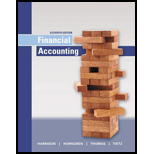
Financial Accounting (11th Edition)
11th Edition
ISBN: 9780134127620
Author: Walter T. Harrison Jr., Charles T. Horngren, C. William Thomas, Wendy M. Tietz
Publisher: PEARSON
expand_more
expand_more
format_list_bulleted
Question
Chapter 8, Problem 1QC
To determine
To find: The correct option, the option which indicates the correct type of investment
Expert Solution & Answer
Explanation of Solution
Available-for-sale securities (AFSS): These are short-term or long-term investments in debt and equity securities with an intention of holding the investment for some strategic purposes like meeting liquidity needs, or manage interest risk.
Justification for correct answer: C’s investment in M’s Stock is less than 2%, so, the investment cannot be equity-method investment. C’s investment in M’s Stock is intended to be held for 3 years and sell off. Hence, it is classified as available-for-sale investment. Hence, option (c) is correct.
Justification for incorrect answers:
- Option (a) is incorrect answer because trading securities are short-term investments in debt and equity securities with an intention of trading and earning profits due to changes in market prices.
- Option (b) is incorrect answer because equity investments are stock instruments which claim significant influence of above 20% but less than 50% in the outstanding stock of the investee company.
- Option (d) is incorrect answer because consolidation is the type of investment which claims significant control and ownership of above 50% in the outstanding stock of the investee company.
Conclusion
Thus, option (c) is the correct answer.
Want to see more full solutions like this?
Subscribe now to access step-by-step solutions to millions of textbook problems written by subject matter experts!
Students have asked these similar questions
What is the primary purpose of accounting?
A) To generate tax revenueB) To record, summarize, and report financial transactionsC) To determine the market value of assetsD) To manage payroll
What are the three main financial statements in accounting?
Can you solve this general accounting question with accurate accounting calculations?
Chapter 8 Solutions
Financial Accounting (11th Edition)
Ch. 8 - Prob. 1QCCh. 8 - Prob. 2QCCh. 8 - Prob. 3QCCh. 8 - Prob. 4QCCh. 8 - Prob. 5QCCh. 8 - Prob. 6QCCh. 8 - Prob. 7QCCh. 8 - Prob. 8QCCh. 8 - Prob. 9QCCh. 8 - Prob. 10QC
Ch. 8 - Prob. 8.1ECCh. 8 - Prob. 8.1SCh. 8 - Prob. 8.2SCh. 8 - Prob. 8.3SCh. 8 - Prob. 8.4SCh. 8 - Prob. 8.5SCh. 8 - Prob. 8.6SCh. 8 - Prob. 8.7SCh. 8 - Prob. 8.8SCh. 8 - Prob. 8.9SCh. 8 - Prob. 8.10SCh. 8 - Prob. 8.11SCh. 8 - Prob. 8.12SCh. 8 - Prob. 8.13SCh. 8 - Prob. 8.14SCh. 8 - Prob. 8.15SCh. 8 - Prob. 8.16SCh. 8 - Prob. 8.17SCh. 8 - Prob. 8.18SCh. 8 - Prob. 8.19SCh. 8 - Prob. 8.20SCh. 8 - Prob. 8.21SCh. 8 - Prob. 8.22AECh. 8 - Prob. 8.23AECh. 8 - Prob. 8.24AECh. 8 - Prob. 8.25AECh. 8 - Prob. 8.26AECh. 8 - Prob. 8.27AECh. 8 - Prob. 8.28AECh. 8 - Prob. 8.29AECh. 8 - Prob. 8.30AECh. 8 - Prob. 8.31AECh. 8 - Prob. 8.32AECh. 8 - Prob. 8.33BECh. 8 - Prob. 8.34BECh. 8 - Prob. 8.35BECh. 8 - Prob. 8.36BECh. 8 - Prob. 8.37BECh. 8 - Prob. 8.38BECh. 8 - Prob. 8.39BECh. 8 - Prob. 8.40BECh. 8 - Prob. 8.41BECh. 8 - Prob. 8.42BECh. 8 - Prob. 8.43BECh. 8 - Prob. 8.44QCh. 8 - Prob. 8.45QCh. 8 - Prob. 8.46QCh. 8 - Prob. 8.47QCh. 8 - Prob. 8.48QCh. 8 - Prob. 8.49QCh. 8 - Prob. 8.50QCh. 8 - Prob. 8.51QCh. 8 - Prob. 8.52QCh. 8 - Prob. 8.53QCh. 8 - Prob. 8.54QCh. 8 - Prob. 8.55QCh. 8 - Prob. 8.56APCh. 8 - Prob. 8.57APCh. 8 - Prob. 8.58APCh. 8 - Prob. 8.59APCh. 8 - Prob. 8.60APCh. 8 - Prob. 8.61APCh. 8 - Prob. 8.62APCh. 8 - Prob. 8.63BPCh. 8 - Prob. 8.64BPCh. 8 - Prob. 8.65BPCh. 8 - Prob. 8.66BPCh. 8 - Prob. 8.67BPCh. 8 - Prob. 8.68BPCh. 8 - Prob. 8.69BPCh. 8 - Prob. 8.70CEPCh. 8 - Prob. 8.71CEPCh. 8 - Prob. 8.72CEPCh. 8 - Prob. 1DCCh. 8 - Prob. 2DCCh. 8 - Prob. 1EICh. 8 - Prob. 1FFCh. 8 - Prob. 1FA
Knowledge Booster
Similar questions
arrow_back_ios
SEE MORE QUESTIONS
arrow_forward_ios
Recommended textbooks for you

 AccountingAccountingISBN:9781337272094Author:WARREN, Carl S., Reeve, James M., Duchac, Jonathan E.Publisher:Cengage Learning,
AccountingAccountingISBN:9781337272094Author:WARREN, Carl S., Reeve, James M., Duchac, Jonathan E.Publisher:Cengage Learning, Accounting Information SystemsAccountingISBN:9781337619202Author:Hall, James A.Publisher:Cengage Learning,
Accounting Information SystemsAccountingISBN:9781337619202Author:Hall, James A.Publisher:Cengage Learning, Horngren's Cost Accounting: A Managerial Emphasis...AccountingISBN:9780134475585Author:Srikant M. Datar, Madhav V. RajanPublisher:PEARSON
Horngren's Cost Accounting: A Managerial Emphasis...AccountingISBN:9780134475585Author:Srikant M. Datar, Madhav V. RajanPublisher:PEARSON Intermediate AccountingAccountingISBN:9781259722660Author:J. David Spiceland, Mark W. Nelson, Wayne M ThomasPublisher:McGraw-Hill Education
Intermediate AccountingAccountingISBN:9781259722660Author:J. David Spiceland, Mark W. Nelson, Wayne M ThomasPublisher:McGraw-Hill Education Financial and Managerial AccountingAccountingISBN:9781259726705Author:John J Wild, Ken W. Shaw, Barbara Chiappetta Fundamental Accounting PrinciplesPublisher:McGraw-Hill Education
Financial and Managerial AccountingAccountingISBN:9781259726705Author:John J Wild, Ken W. Shaw, Barbara Chiappetta Fundamental Accounting PrinciplesPublisher:McGraw-Hill Education


Accounting
Accounting
ISBN:9781337272094
Author:WARREN, Carl S., Reeve, James M., Duchac, Jonathan E.
Publisher:Cengage Learning,

Accounting Information Systems
Accounting
ISBN:9781337619202
Author:Hall, James A.
Publisher:Cengage Learning,

Horngren's Cost Accounting: A Managerial Emphasis...
Accounting
ISBN:9780134475585
Author:Srikant M. Datar, Madhav V. Rajan
Publisher:PEARSON

Intermediate Accounting
Accounting
ISBN:9781259722660
Author:J. David Spiceland, Mark W. Nelson, Wayne M Thomas
Publisher:McGraw-Hill Education

Financial and Managerial Accounting
Accounting
ISBN:9781259726705
Author:John J Wild, Ken W. Shaw, Barbara Chiappetta Fundamental Accounting Principles
Publisher:McGraw-Hill Education